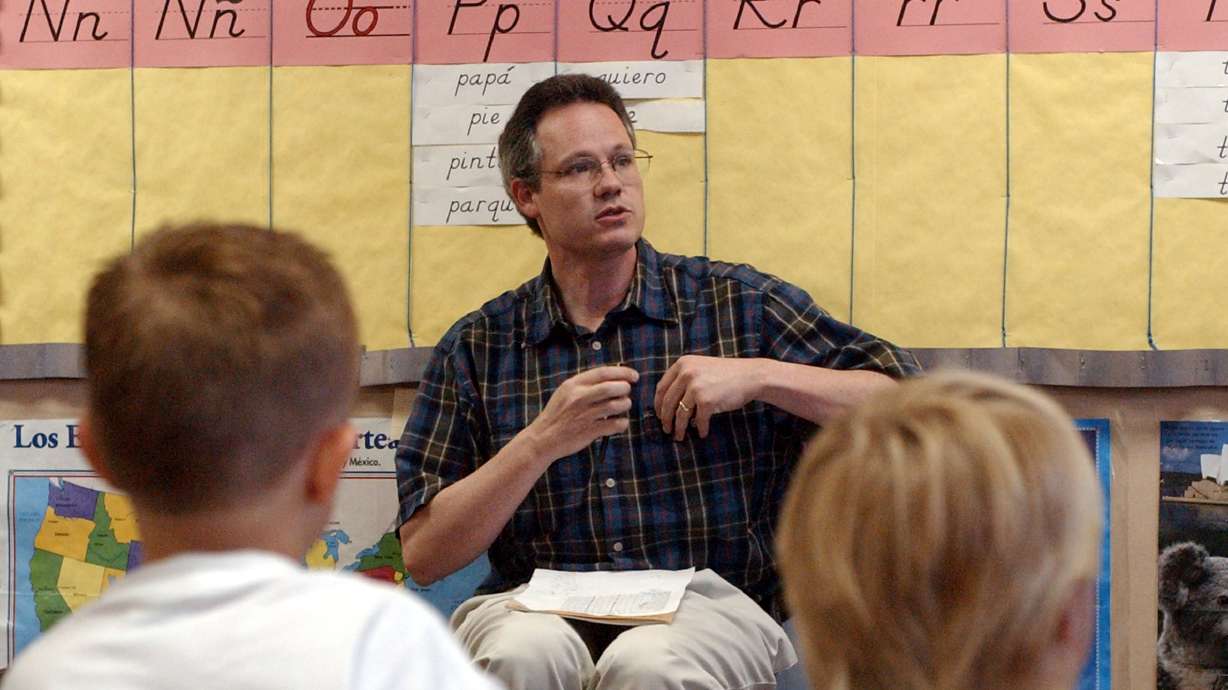Estimated read time: 4-5 minutes
This archived news story is available only for your personal, non-commercial use. Information in the story may be outdated or superseded by additional information. Reading or replaying the story in its archived form does not constitute a republication of the story.
ALPINE — For 17-year-old Max Millar, teaching little ones isn't just about hand-painting flowers and pots, and then giving them to senior citizens — although that is one aspect of his job as a part-time educator at the Sunshine Academy preschool.
Millar helped his students — who were roughly between the ages of 4 and 10 — paint the pots and prepare the flowers for the senior citizens for Mother's Day.
"I wanted to be a part of this project to show that young men can make a difference in children's lives, and to make the grandmothers at River Meadows Senior Living in Alpine feel special," Millar said in an email.
The American Heritage high school student said that the service project — and teaching in general — brings him and the children fulfillment and that he hoped something as small as delivering flowers could show the positive influence of male teachers.
"I hope that more young men will be inspired to join the ranks of early childhood education teachers, where they can make a real difference in the lives of children and the members of their communities," Millar said.
While male teachers can be positive role models, according to Millar, the male-female teacher discrepancy doesn't reflect positive statistics — 74.3% of the country's teachers are female, while only 25.7% are male, according to career site Zippia's research and its assessment of 30 million teacher profiles.
And in Utah, the disparity is even higher; according to the Utah State Board of Education, 77% of teachers in the public education system, special education system and the Utah Schools for the Deaf and Blind are female, and 23% are male.
"It's becoming even more and more difficult to become a teacher that makes a difference — whether you're a man or a woman — because of just the workload of it and the requirements of it," said Rep. Daniel Johnson, R-Logan. "I don't think there are enough male teachers anywhere."
As a previous principal of the Edith Bowen Laboratory School and avid education supporter, Johnson noted that more than 40% of teachers in Utah quit after five years of teaching.
"Currently, we have a lot of social issues that I think really affect the recruitment and retention of teachers right now," Johnson said. "I've heard several people tell me that they're not going to encourage their kids to become teachers, and it's really sad."
Joel Lopez, a teacher and soccer coach at Edith Bowen, said that when his parents found out he wanted to teach, they expressed disapproval — instead encouraging him to become a doctor or engineer.
One strategy Utah could use to employ more male teachers, Lopez noted, is to give teachers the same high respect as first responders and other coveted positions.
"If you frame it in that way as teachers being leaders and leading the way, then it makes it easier for males to find it an attractive profession," Lopez said.
And it may not just be social stigma preventing men from becoming teachers, Johnson said. The financial struggles associated with teaching — along with the pressure to provide for a family — could cause anxiety for men.
"A lot of men maybe didn't choose education because they're a family person, they want to get married, have children, be able to have a life where they can take care of their family based on the pay that they're receiving," Johnson said.
Derek Sego, a regional manager at Sunshine Academy, said that many men may not become educators because they may see that they don't "fit" in the role, viewing teaching and helping children as a job more suited for women.
"We're trying to overcome historical factors, how we viewed roles of males and females, and then, you know, how that's changed," Johnson said.
Sego said that male teachers can provide a key role modeling influence for younger children — one that is different, and yet just as important as female role models.
"I think it's great to have male and female figures present in children's lives. I think that what it does is helps the kids, especially the young boys," Sego said. "I think it's really important, the way we treat kids; they are our future — and I think we all have a responsibility to be examples to them."
And there isn't just a lack of male educators and role models, but male teachers of color are few and far between compared to white and female demographics, according to the Zippia report.
Lopez, who has a bachelor's in Latin American studies and another bachelor's in education from Utah State University, noted how his Hispanic background has enabled him to help all students feel included and loved.
"It helps bring that perspective to education so that when we do have students who don't fit that norm or who are a little outside of the mainstream — they're like, 'Oh, there is a place for me as well,'" Lopez said. "And so I think one of the things that we can do to attract males of color, like I said, is making it a profession that is valued in society."
Correction: An earlier version named Max Millar as Mike Miller. That has been corrected.









